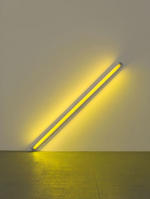Wednesday, August 31, 2005
Simplify, Simplify
 As I walked through the Dan Flavin retrospective at the Museum of Contemporary Art in Chicago last weekend, I couldn’t help but think of what Henry David Thoreau wrote in Walden more than 150 years ago, “Simplicity, simplicity, simplicity! I say, let your affairs be as two or three, and not a hundred or a thousand.... Simplify, simplify.”
As I walked through the Dan Flavin retrospective at the Museum of Contemporary Art in Chicago last weekend, I couldn’t help but think of what Henry David Thoreau wrote in Walden more than 150 years ago, “Simplicity, simplicity, simplicity! I say, let your affairs be as two or three, and not a hundred or a thousand.... Simplify, simplify.”The first gallery of the installation dramatically shows what happened when Flavin simplified his approach to art making. As Thoreau suggested, Flavin’s work became a completely different thing, a much better thing, as the complexity was boiled away.
In 1963, Flavin distilled his work down to a single element—light. With the diagonal of May 25, 1963 (to Constantin Brancusi) (at left), Flavin moved from using lit bulbs to enhance monochromatic Masonite panels to presenting the effect made by the bulb as the art object.
Flavin’s move toward radically simplifying a style he had worked to develop reminded me of a similar path Mark Rothko took in 1949—a path that was wonderfully illustrated in the Pace Wildenstein exhibition, Mark Rothko: A Painter’s Progress, The Year 1949. Over 1949 Rothko simplified the compositional field in his work until he finally ended up with what came to be seen as his signature style—two or three simple rectangular bands of color floating on a background.
These two paths toward simplicity should serve as case studies for young artists today. Often it’s finding the essential kernel of the work and paring back everything but that—painfully difficult as it is to do—that leads to the development of a clear, unique, mature style.